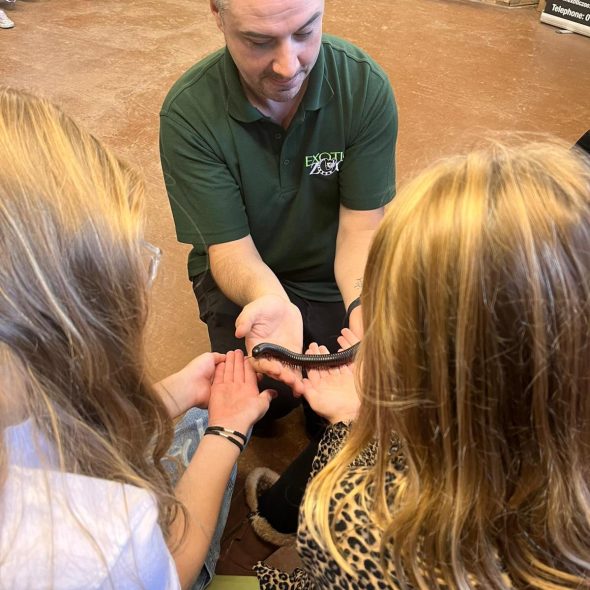No products in the basket.
We work with local schools, colleges and education providers to offer unique animal and environment educational workshops. Invite Exotic Zoo to join you in your classroom, or join us at the zoo in our wildlife academy and entry into the zoo.
We have great links with land-based colleges for animal management courses whether this be post 16 education or Higher Education students, as well as working with the local council running workshops for NEATS, travel to learn and other working outside the classroom projects.
We cover all age groups, supporting the national curriculum as well as offering bespoke courses and workshops for different social groups.
Think outside the box and choose Exotic Zoo to help out with some less obvious lessons like art classes, photography, geography and so much more! Why not let us be part of your STEM events, open days or even a great treat for the end of term.
We also pride ourselves on offering animal assisted therapy and interventions through care providers to children and adults with learning difficulties, the elderly, as well as a whole host of other hard to reach groups in and around the area.
IF YOU HAVE AN EDUCATIONAL PROJECT WE CAN HELP WITH PLEASE CALL US NOW – WE WOULD LOVE TO HEAR FROM YOU

Our unique and engaging wildlife academy is an amazing space for groups of people to meet some unusual species and learn all about them!
Join us in our Wildlife Academy here at Exotic Zoo for a really wild learning outside the classroom experience and enjoy the zoo while you are here.
We cover all age groups, supporting the national curriculum as well as offering bespoke courses and workshops for different social groups.
Compare animal body structures with our own. Starting with invertebrates and then working along the classification of vertebrate animals including amphibians, reptiles, birds and mammals.
Explore different habitats around the world and meet exotic animals from the rainforest, desert, grassland and woodlands. Identify the different features these exotic animals have which helped them to be able to adapt to the environment they live in.
Looking at the life cycles of a wide range of exotic animals including invertebrates, amphibians, reptiles, birds and mammals.
This huge continent has a wide variety of animals to offer. Discover the life of the most well adapted animals from the worlds hottest desert, to the life of a river dwelling ambush predator. Home to some giant invertebrates, children can have the opportunity to hold some of the worlds biggest Invertebrates as well as amphibians, reptiles and mammals.
Find out what different animals need for basic survival and how we can provide that for them. Introducing a range of exotic animals from different habitats including rainforest, desert and grassland animals.
An insight to the incredible biodiversity in this habitat. Pupils will identify the structure of a rainforest, how to look after the environment by sustainability and conversation. Meeting some amazing exotic rainforest predators lurking in the different layers hoping to catch some very well adapted and camouflage prey animals.
Join us on a journey back in time, to learn about dinosaurs and how fossils tell us about the world they inhabited. Learn about fossils- What are they? And how they were formed. How scientists date and use them to teach us about dinosaurs.
And then……………
Explore our natural history museum with extinct animals spanning from the start of time up to the recent Dodo!
Identifying key variations between the animals in different classifications. Pupils will meet various exotic species from a number of classifications, some of which have been subject to selective breeding and pros and cons will be explained in comparison to wild type species.
Looking at evidence that life has changed over a long period of time. Meeting a python that has claws which once had legs, a millipede that once lived in the ocean and now lives on land and many more examples of changes. Exploring how and why they have needed to adapt to ever changing environments.